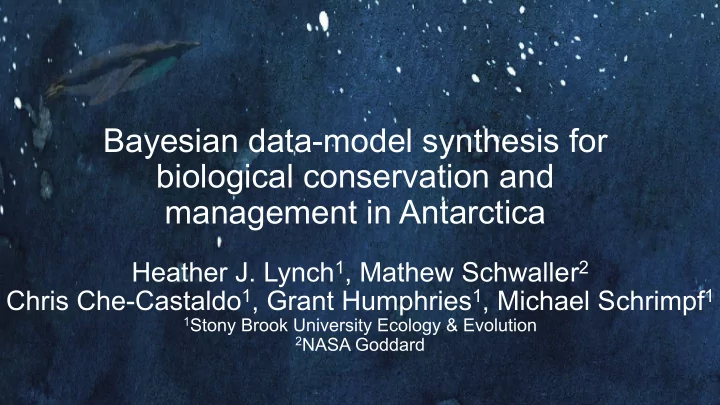

Bayesian data-model synthesis for biological conservation and management in Antarctica Heather J. Lynch 1 , Mathew Schwaller 2 Chris Che-Castaldo 1 , Grant Humphries 1 , Michael Schrimpf 1 1 Stony Brook University Ecology & Evolution 2 NASA Goddard
Mapping Application for Penguin Populations and Projected Dynamics (MAPPPD) Automated pipeline for policy-relevant information “Data-to-policy” pipeline
penguinmap.com
Now that we have MAPPPD, Source: AAD what can we do? Adélie Study the efficacy of the Adélie penguin as an indicator species for adaptive management of Antarctic fisheries.
What to do with patchy multi-site data? SITE 1979 1980 1981 1982 1983 1984 1985 1986 1987 1988 1 X X X Need models to 2 X X X X estimate the unknown 3 X population in years of 4 X missing data (‘latent 5 X X X states’). 6 X 7 X 8 X X 9 X This is what we 10 X X X X X X X are usually doing… 11 X X X X 12 X 13 X 14 X X X X 15 X X X X 16 X
What to do with patchy multi-site data? SITE 1979 1980 1981 1982 1983 1984 1985 1986 1987 1988 1 X X X Need models to 2 X X X X estimate the unknown 3 X population in years of 4 X missing data (‘latent 5 X X X states’). 6 X 7 X 8 X X 9 X This is what we 10 X X X X X X X are usually doing… 11 X X X X 12 X 13 X 14 X X X X 15 X X X X 16 X …but this is often what we need.
Adélie Abundance ~ Covariates 268 Adélie populations around Antarctica
Process model “true” abundance = f(biological covariates, process noise) Observation model Observed abundance = g(“true” abundance, in situ precision) X X X Z Z Z Z X Z Z Z Z X X Z Z Z Z X Z Z Z Z X X Z Z Z Z X X Z Z Z Z X Z Z Z Z X X Z Z Z Z Z Z Z Z X X Z Z Z Z Observed counts “true” abundance
What did we find? 1) Interannual growth rates positively associated with maximum winter sea ice in the previous several years and negatively associated with maximum summer sea ice in 𝑢 −4 2) Almost all of the interannual variability in growth rates remains unexplained
At the site level Data-rich sites Data-poor sites Cape Crozier Lauff Island How does the model infer abundance when there is no data? Litchfield Island Cape Cornish Shared covariates allow for a ‘best- guess’ in years with missing data . Est. from nest counts in black Est. from chick counts in red
NB: Inferring missing (“latent”) Remarkably consistent with states is necessary if you are Cimino et al. (2016) who inferred going to model abundance abundance trends from habitat within regions suitability models fit using presence – absence data
Abundance (Millions of breeding pairs) Everything south of 60 º S
Where do we go from here? o High-resolution remote sensing is answering questions we were not even asking 5-10 years ago (and not just for penguins!), and MAPPPD is a key component of sharing this new data stream with policymakers o No longer have to trade spatial resolution for spatial extent o We now have software that can provide Antarctic stakeholders quasi-real time information on abundance and distribution at any user-defined spatial scale (Population " SSMUs " Sub- areas " MPAs " Continent) o Data rich model system for quantitative and spatial ecologists (but we need to get them engaged with the data)
A data science competition is a flavor of citizen science that we had not initially anticipated, but an amazing way to spread the word and get some new models for our decision support tool. In just the first three weeks, 414 people have signed up to participate and 208 unique models already submitted.
What we’ve completed to date: What we will do in the next year: - Underlying PostgreSQL database for all four Antarctic - Add ensemble model forecasts penguins - Integrate Landsat retrievals and clean-up workflows - Front end application essentially complete for transition to partner organization - Underlying population dynamics model for Adélie penguins is complete - Archival Landsat survey (L4,L5,L7,L8) complete - Characterization of ground targets with field spectrometer complete - Occupancy model for non-penguin Antarctic seabirds complete and displayed in MAPPPD - MAPPPD is currently in use for the community Thanks NASA Ecosystem Forecasting (and extra special thanks for supporting the data science competition!). Questions??
Recommend
More recommend